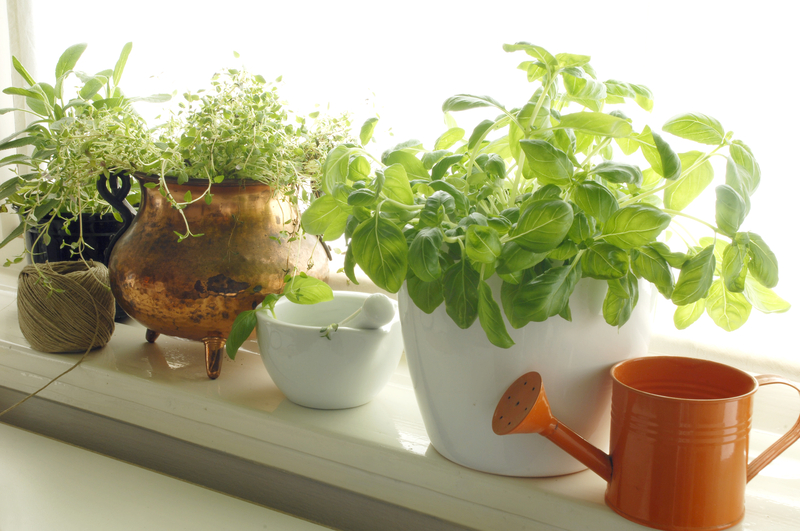A New Beginning: Starting a Neglected Garden Makeover
Posted on 21/06/2025
A New Beginning: Starting a Neglected Garden Makeover
Do you look out at an unruly jungle rather than a vibrant garden retreat? You're not alone! Many homeowners inherit or develop neglected garden spaces for countless reasons--time, budget, or the overwhelming nature of starting over. But a neglected garden makeover is more than a landscaping project; it's the promise of a new beginning. In this comprehensive guide, we'll walk you through each phase of your garden transformation, from assessment to planting, providing practical tips and inspiring ideas to launch your stunning new outdoor sanctuary.
Why Begin a Neglected Garden Makeover?
Overgrown lawns, suffocating weeds, and lifeless flowerbeds can drain the beauty and value of your property. However, embracing the challenge of a neglected garden renovation offers immense rewards:
- New opportunities for creative landscaping
- Increased property value and curb appeal
- Improved well-being through connection to nature
- Space for relaxation and entertaining guests
Transforming a neglected garden is your chance to create a personalized green space that resonates with your lifestyle and aspirations--from lush cottage gardens to minimalist retreats.

Step 1: Assessing Your Garden's Current Condition
Successful garden revitalization begins with an honest assessment. Before you dream of vibrant blooms or vegetable patches, walk through your garden with a critical eye:
Take Inventory
- List existing plants: Note any surviving shrubs, trees, or flowers and their health.
- Identify invasive species: Watch for aggressive weeds that may return if not fully removed.
- Check for structural issues: Inspect fences, raised beds, patios, and other hardscape elements for repair needs.
Soil Evaluation
- Soil texture: Is it sandy, clay, or loamy?
- Drainage: Are there soggy patches after rain?
- pH testing: Know if your soil is acidic or alkaline to choose compatible plants.
Keep notes and take "before" photos. These will help you celebrate your progress as the neglected garden makeover unfolds.
Step 2: Planning Your Garden Transformation
Every successful overgrown garden makeover starts with a thoughtful plan. Visualize and map out your goals before lifting a single trowel:
Define Your Purpose
- Relaxation oasis: Seating, a hammock, or water features
- Edible gardens: Vegetable patches, fruit trees, or herb spirals
- Children's play area: Safe, open spaces for activities
- Wildlife-friendly habitat: Native plants, pollinators, bird feeders
Sketch a Basic Layout
- Use graph paper or digital tools to plot the area.
- Mark existing features and intended improvements.
- Consider sun and shade patterns throughout the day.
Set a Realistic Budget and Timeline
- Small steps: Tackle one area at a time, if necessary.
- Seasonal planting: Align hard work with optimal planting times.
- DIY versus professional help: Decide what you can manage alone, and where to employ expert landscapers.
Step 3: Clearing and Cleaning Up the Mess
A neglected yard transformation begins with hard, satisfying groundwork. This stage is crucial for a long-lasting, low-maintenance garden.
Tools You'll Need
- Gloves and eye protection
- Pruning shears and loppers
- Rake and garden fork
- Spade, hoe, and wheelbarrow
- Heavy-duty waste bags or compost bins
Clearing Procedures
- Remove debris and litter: Old plant pots, dead branches, broken furniture, or rubbish
- Cut back overgrowth: Prune shrubs, trim hedges, and mow down tall grass
- Uproot weeds: Remove roots to prevent regrowth, especially of invasive varieties
- Dispose responsibly: Compost what you can, recycle, or use local green waste facilities
Don't get discouraged if this phase takes several weekends. Progress can be slow, but every bag of weeds removed is a step closer to your revitalized garden!
Step 4: Repair, Restore, or Replace Hardscape Features
Once cleared, you'll have a better idea of what hardscape structures--paths, patios, sheds, or fences--need attention:
- Repair: Fix leaning fences, broken gates, or cracked paving stones where possible
- Restore: Power-wash dirty surfaces, oil wood, and repaint faded areas
- Replace: Remove rotten structures, install new edging, or lay down fresh mulch for an instant facelift
Tip: Upcycling old materials (like bricks or timber) from your cleanup can add rustic charm while saving money during your backyard makeover.
Step 5: Improving Soil and Preparing Garden Beds
Healthy soil is the silent hero of any neglected garden rescue. After physical clean-up, focus on restoring fertility and structure to pave the way for thriving plant life:
Soil Restoration Tips
- Add organic matter: Mix in compost, well-rotted manure, or leaf mold
- Aerate: Dig or fork the earth to alleviate compaction
- Add soil amendments: Lime, sand, or peat as recommended by your soil test
- Mulch: Retains moisture, suppresses weeds, and gradually improves soil as it breaks down
This step can drastically enhance plant health and minimize garden maintenance in the future.
Step 6: Choosing Plants for a Low-Maintenance, Stunning Garden
When reimagining your overgrown garden restoration, plant selection is key to ongoing success. Consider these tips as you browse your local nursery or catalog:
Prioritize Native and Resilient Species
- Native plants: Adapted to local climate and soils, often drought-tolerant
- Perennials: Return year after year with minimal care
- Groundcovers: Suppress weeds and stabilize soil
- Evergreens: Maintain year-round structure and color
Layer Your Planting
- Vertical interest: Mix tall shrubs, mid-level flowers, and low groundcovers
- Seasonal interest: Plan for spring bulbs, summer blooms, autumn foliage, and winter textures
For those seeking immediate results, consider a mix of fast-growing annuals and slower, long-term perennials.
Step 7: Installing Features and Personalizing Your Outdoor Space
The most enjoyable part of a neglected backyard makeover is infusing your personality. Here are ideas to add beauty and utility:
- Seating: Benches, chairs, or hammocks for relaxation
- Pathways: Gravel, stepping stones, or woodchips to guide the eye and foot traffic
- Lighting: Solar lights, fairy lights, or lanterns for evening ambiance
- Water features: Birdbaths, small ponds, or bubbling fountains
- Creative touches: Upcycled planters, sculptures, wind chimes, or painted signs
- Kids' zones: Sandpits, treehouses, or chalkboard walls
Tip: Personal features not only enhance enjoyment but make your restored garden uniquely yours.
Step 8: Simple Maintenance to Prevent Future Neglect
After your grand garden revival, shift focus from heavy labor to simple, consistent care routines:
- Weekly tasks: Water, weed, and inspect for pests or diseases
- Monthly: Prune, mulch, and feed as needed
- Seasonally: Plant bulbs, rake leaves, refresh mulch, and plan for seasonal color
Maintenance doesn't have to be burdensome. Automate what you can--install drip irrigation, use weed barriers, and plant densely to minimize weeds. Celebrate small victories as you cultivate a lasting paradise!
Inspiring Real-Life Neglected Garden Makeover Stories
Hesitant to start? Draw inspiration from these garden transformations:
- The Wild Jungle: A homeowner turned a bramble-choked lot into a pollinator haven with wildflower meadows and bee hotels.
- The Family Retreat: What was once filled with broken toys and weeds now thrives as an edible garden, play lawn, and alfresco dining area.
- The Urban Oasis: An unused concrete yard was softened with container gardens, vertical planters, and cozy lighting.
Every new beginning in the garden is a chance to tell your own story, no matter the starting point.

Frequently Asked Questions (FAQ) About Neglected Garden Makeovers
How long does a garden makeover take?
Depending on size and neglect level, it can take from a few weekends to several months. Break tasks down into stages for steady progress and celebrate each milestone.
Is it expensive to restore a neglected garden?
Costs vary widely. Save by reusing materials, growing from seeds, and tackling DIY projects. Set a realistic budget and prioritize urgent repairs and plantings first.
Do I need to dig out all old plants?
Not always! Some "lost" plants may respond to trimming and fresh soil. However, remove anything dead, diseased, or invasive for a healthy fresh start.
How do I keep my new garden from becoming neglected again?
Design for low maintenance: choose resilient plants, use mulch, install automated irrigation, and set aside regular time for simple upkeep tasks.
Conclusion: Embrace Your Neglected Garden's New Beginning
Starting a neglected garden makeover is about more than aesthetics--it's about reclaiming joy, peace, and pride in your outdoor space. By assessing, planning, and tackling manageable steps, anyone can transform a forgotten plot into a thriving retreat. No experience? No problem. Your garden's journey from neglect to spectacular will be uniquely rewarding and might even ignite a lifelong passion for gardening.
Ready to begin your neglected garden transformation? Start small, stay persistent, and remember: every weed pulled is a victory and every flower that blooms is a reminder that new beginnings are always possible.
Share your before-and-after stories in the comments and inspire others to embark on their own garden makeovers!

